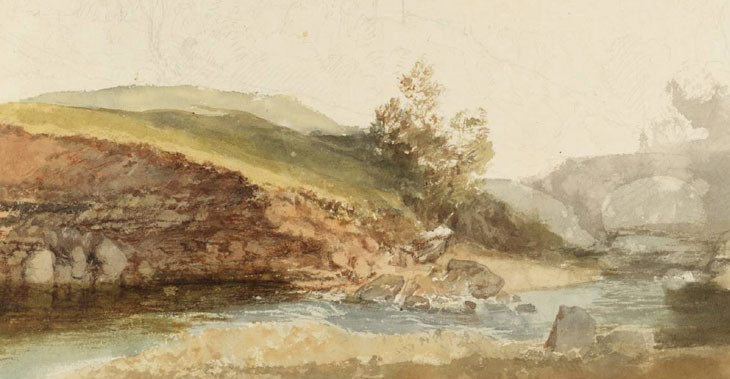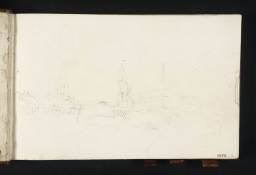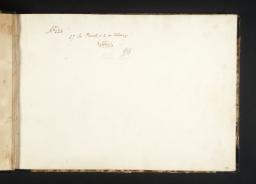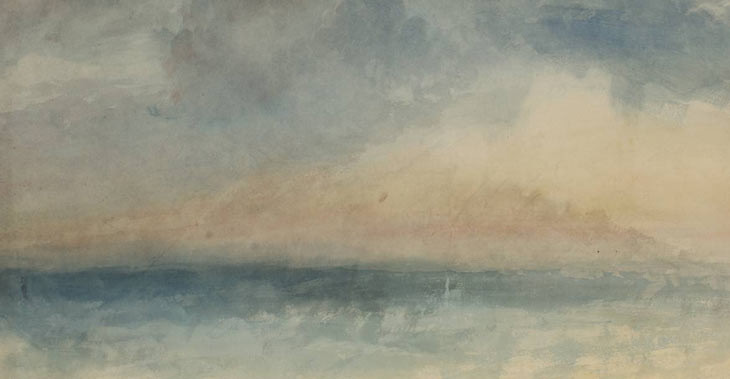Sketchbooks from the Tour of County Durham and Northumberland 1817

From the entry
Turner toured County Durham and Northumberland in the autumn of 1817, gathering material for works commissioned by two wealthy and somewhat unconventional new patrons, Lord Darlington and Lord Strathmore. Two sketchbooks, the large Raby (Tate; Turner Bequest CLVI) and the relatively small Durham, North Shore (Tate; Turner Bequest CLVII), are catalogued here in relation to the tour, as Finberg established in his 1909 Inventory of the Bequest. Turner had visited the area as early as 1797 as part of a more extensive tour of the North, and on other occasions before and after 1817, depicting some of the well-known sites such as the city of Durham (see the entry for D12325; CLVII 6), and later the industrial aspects of the region (see under D12323; CLVII 4). He had most recently passed through in 1816. In August and September 1817, he had toured the battlefield of Waterloo, the River Rhine and Holland on his first visit to Europe since the end of the Napoleonic Wars in 1815. His day-to-day route is recorded in the ...
References
Turner toured County Durham and Northumberland in the autumn of 1817, gathering material for works commissioned by two wealthy and somewhat unconventional new patrons, Lord Darlington and Lord Strathmore. Two sketchbooks, the large Raby (Tate; Turner Bequest CLVI) and the relatively small Durham, North Shore (Tate; Turner Bequest CLVII), are catalogued here in relation to the tour, as Finberg established in his 1909 Inventory of the Bequest.1 Turner had visited the area as early as 1797 as part of a more extensive tour of the North, and on other occasions before and after 1817, depicting some of the well-known sites such as the city of Durham (see the entry for D12325; CLVII 6), and later the industrial aspects of the region (see under D12323; CLVII 4). He had most recently passed through in 1816.2
In August and September 1817, he had toured the battlefield of Waterloo, the River Rhine and Holland on his first visit to Europe since the end of the Napoleonic Wars in 1815. His day-to-day route is recorded in the Itinerary Rhine Tour sketchbook (Tate D12695, D12696; Turner Bequest CLIX 99a–100), tailing off in mid-September.3 Finberg noted that he ‘seems to have sailed from Rotterdam on or about the 15th of September’, dismissing as ‘fiction’4 Walter Thornbury’s account of what followed: ‘On his return from this particular tour, Turner landed at Hull, and came straight to Farnley. Before he had even taken off his great-coat he produced these drawings, rolled up slovenly and anyhow, from his breast-pocket. Mr. Fawkes, for some 500l., bought them all’.5 Although Turner did eventually arrive at Farnley Hall near Leeds, the home of his friend and patron Walter Fawkes, where ‘drawings’ – watercolours of Rhine views – changed hands as described in due course below, this was not until he had visited County Durham and Northumberland.
James Hamilton’s suggestion that the work necessitating the present tour ‘may have been arranged before [Turner] left England’6 seems highly probable. Hamilton states that he crossed from Rotterdam to Harwich in Essex ‘and almost immediately travelled north’.7 As discussed below, Cecilia Powell has shown that Turner still had his Itinerary Rhine Tour and other sketchbooks with him, originally speculating that ‘it appears that he did not even stop in London to empty his pockets’,8 but subsequently stating that he had been home to the capital before heading north.9 The Durham, North Shore sketchbook opens with views on the pier at Sunderland, before a sequence progressing inland through County Durham to the vicinity of Raby Castle, so there is a further possibility: Turner could have sailed to the area via the East Coast (a route he certainly took to Edinburgh in 1822,10 while Thornbury quotes an anonymous source concerning ‘Turner’s trips to the north, to which he always went by a collier’11). Brief financial accounts inside the front cover of the Durham, North Shore book (D40918) suggest that he stayed at or visited Newcastle upon Tyne, a few miles north-west of Sunderland, before going on to Durham.
Lord Darlington had commissioned a painting of Raby Castle, County Durham, his seat between Bishop Auckland and Barnard Castle. Turner also took the opportunity to make studies in the surrounding area, between the Rivers Wear and Tees as far south-west as Bowes, and at Durham itself to the north-east. William Harry Vane, 1st Duke of Cleveland (1766–1842), was the 3rd Earl of Darlington at the time of Turner’s 1817 visit, subsequently being created Marquess of Cleveland in 1827 and Duke in 1833. Before succeeding to the earldom in 1792 he had been an MP, and later look an interest in political reform. A widower, in 1813 he had married Elizabeth Russell, his long-term mistress, who was the daughter of a market gardener. He was a passionate huntsman, keeping two packs of foxhounds (of larger and smaller breeds) and riding with them on alternate days for much of each year; he also bred racehorses.12 As James Hamilton has shown, Lord Darlington was by his own account on terms of ‘great intimacy’ with Walter Fawkes, who may have been the catalyst for the commission.13
The largely fourteenth-century Raby Castle was originally the seat of the Nevill(e) family before being forfeited to the Crown following the Catholic Rising of the North in 1569; in 1626 it was bought by Sir Henry Vane, the 3rd Earl’s ancestor, and remains in family hands, albeit collateral to the 3rd Earl’s line, its structure fundamentally unchanged since Turner’s time.14
There is an 1804–5 series of paintings of Lord Darlington out hunting elsewhere in the region, by John Nost Sartorius (Tate T02368–T02371). These are notable in the light of Turner’s drawings of horsemen and hounds at Raby, and his subsequent toning down of the fox-hunting elements of the commissioned oil painting, Raby Castle, the Seat of the Earl of Darlington (Walters Art Gallery, Baltimore),15 which attracted negative criticism on first being exhibited at the Royal Academy in 1818. Huntsmen and dogs at rest are prominent in Turner’s concurrent watercolour of Raby (untraced; see the entry for D12293; CLVI 19a),16 which was engraved in 1820 for Surtees’s History of Durham, as discussed below.
As Cecilia Powell has shown, the Itinerary Rhine Tour sketchbook contains several views of York (Tate D12595, D12596, D12603, D12605, D12633; Turner Bequest CLIX 45a–46, 49a, 50a, 65a), and he used it at Raby for studies of deer (D12609, D12611–D12613; CLIX 52a, 53a, 54, 54a), dogs (D12627–D12631; CLIX 62a, 63, 63a, 64, 64a), horsemen (D12616, D12632; CLIX 56, 65) and the castle (D12607, D12608, D12609, D12610, D12617; CLIX 51a, 52, 53, 56a), to supplement those in the Raby sketchbook.17 Studies of billowing clouds in these and other sketches probably informed those in the oil of the castle with the sun breaking through and the watercolour of it with a rainbow (D12606, D12607, D12614; CLIX 51, 51a, 55).
Powell has suggested that Turner may have met his old acquaintance Newby (or Newbey) Lowson (1773–1853), Lord Darlington’s friend and County Durham neighbour, on this visit.18 Lowson, a country gentleman with antiquarian and artistic interests, had accompanied Turner on his journey through the Alps in 1802 during his first Continental tour.19 As a list in Shipwreck (1) sketchbook (Tate D05377; Turner Bequest LXXXVII 2) shows, he had been a subscriber to the mezzotint of Turner’s Shipwreck, published in 1807. In 1816 had travelled through Switzerland and down the Rhine with Lord Darlington, and it is possible that Turner may even have consulted them before his own 1817 Rhine tour.20 Powell notes that a list of watercolour commissions in hand around 1817–18 in the Guards sketchbook (Tate D13315; Turner Bequest CLXIV 58a) includes the entry ‘Lowson – 1’. No Turner belonging to Lowson is now traceable, although he is supposed to have owned a watercolour which he left to Elizabeth Garthwaite, his housekeeper.21 Two detailed drawings in the Durham, North Shore sketchbook (D12339–D12341 and D12342–D12344; CLVII 17a–18, 19 and CLVII 19a–20, 21) show Witton Tower, Lowson’s house at Witton-le-Wear, in a wider setting, and either could have been used as the basis of a commissioned work.
Lowson’s name appears in the Guards sketchbook immediately below the entry ‘Lo Strathmore – 4’. John Lyon-Bowes, 10th Earl of Strathmore (1769–1820), was Lord Darlington’s near neighbour at Streatlam Castle, just south-west of Raby. Perhaps as an unexpected bonus to his work for Lord Darlington,22 Turner made drawings at Streatlam in the Raby sketchbook, and travelled north to Northumberland with Lord Strathmore on a new leg of the tour, probably in mid October (see Turner’s letter quoted below). There he explored the Strathmore estates at Gibside, near Gateshead, and Hylton Castle, on the outskirts of Sunderland; he also travelled westwards up the Tyne Valley to the Northumberland castles of Prudhoe and Bywell. Two watercolours of Gibside and one of Hylton are known; a fourth subject, implied by the numbering in the Guards list, might have been a view of Streatlam, although there is no direct evidence of such a work.
Streatlam Castle, the Bowes family seat since the fourteenth century, formerly stood about three miles south-west of Raby Castle, and about the same distance north-east of Barnard Castle. The rather severe Baroque house Turner shows was built in about 1717–1823 for Sir William Blakiston Bowes (great-grandfather of the 10th Earl) on the site of a medieval castle; it was demolished in 1927 and the remains of the original castle at its core were blown up in 1959. Old photographs document the appearance of the house and its immediate setting.24
Gibside came into the family by marriage in 1693, and a new house was built there between 1603 and 1620. Sir William Blakiston Bowes’s son George had made many improvements to the estate. George Bowes became the father-in-law of the 9th Earl of Strathmore, who was succeeded in 1776 by his son, Turner’s patron. The latter had done much to restore the Gibside estate after the depredations of his mother’s notorious second husband. By his unconventional liaison with Mary Millner, a Streatlam village girl he eventually married the day before his death in 1820, Lord Strathmore was the father of John Bowes (1811–1885), founder of the Bowes Museum at Barnard Castle. (He was also a collateral ancestor of Queen Elizabeth The Queen Mother, née Lady Elizabeth Bowes-Lyon.)25
Hylton Castle had no ancient Bowes connections. It was built by Sir William Hylton in about 1400, and his descendants died out in 1746, having added ‘Gothick’ north and south wings early in the eighteenth century. George Bowes’s widow later bought the castle but did not reside there, and in 1812 the 10th Earl (her grandson) leased it to a Simon Temple, who refurbished it and the adjacent St Catherine’s Chapel. Later in the century it housed a school, and the wings recorded by Turner were demolished; it later passed from the National Coal Board to the Ministry of Works and subsequently to English Heritage.26 Probably always the most substantial part of the castle, only the shell of the large gatehouse remains, and the chapel is a roofless ruin.
Turner eventually returned south, coming to rest at Farnley Hall, home of his longstanding friend and patron Walter Fawkes (who also features in the Guards list of works in hand, as ‘Fawkes – 3’). In a letter from Farnley to James Holworthy postmarked 21 November 1817, Turner reviewed his recent movements, writing of his ‘fugitive disposition from place to place’ and his wish ‘to return to town’.27 He referred to his friend Henry Gally Knight of Langold Hall, Nottinghamshire, which would have been on his route south towards London:28 ‘I had written a letter to say that I could be with him at Langold from the 23rd to the 29th October, but Lord Strathmore called at Raby and took me away to the north’.29 Evelyn Joll has dated the sketches of Gibside (in particular D12267, D12268; CLVI 5a–6) as ‘probably’ from the week of 23–29 October,30 although this is perhaps too literal an interpretation of Turner’s letter.
Thus, contrary to Thornbury’s romantic and unsubstantiated account, it was at Farnley or in the course of the previous few weeks in the north that Turner worked to complete the fifty or fifty-one Rhine watercolours (since dispersed to many public and private collections)31 which Walter Fawkes apparently bought immediately as a set for £500.32 He worked from his Continental sketchbooks, basing the compositions on drawings in the Itinerary Rhine Tour book mentioned above, and the Waterloo and Rhine and Rhine sketchbooks (Tate; Turner Bequest CLX, CLXI).33 As Finberg has shown, Turner was already at Farnley by 15 November, when Mrs Fawkes noted his presence upon her own arrival; and he was back in London at a Royal Academy General Meeting on 10 December, having missed the previous one on 1 December.34
Various works resulted directly from the tour, the most prominent being Lord Darlington’s painting of Raby, shown at the Royal Academy in 1818 along with the contrasting subjects Dort, or Dordrecht (Yale Center for British Art, New Haven)35 and The Field of Waterloo (Tate N00500),36 derived from the preceding Continental tour. James Hamilton has described the view of the castle as ‘perhaps the greatest Rubens that Rubens never painted’ and notes Turner’s recent experience of the Flemish artist’s works in Antwerp.37 The panoramic studies for it in the Raby sketchbook show Turner’s response to the grandeur of the castle’s setting.
Four watercolours were also made soon after the tour from drawings in the Raby sketchbook, of which three were engraved for the second volume of The History and Antiquities of the County Palatine of Durham (London 1820) by local historian Robert Surtees (1779–1834).38 The first volume (1816) had included illustrations of antiquities supported by general subscribers, but not of ‘castles and other residences of gentlemen’, hence Turner’s commissions for the 1820 volume.39 An untraced watercolour of Raby Castle for Lord Darlington has already been mentioned, and three were produced for Lord Strathmore: Gibside, Co. of Durham,40 showing the southern aspect of the estate, a companion view from the north (both Bowes Museum, Barnard Castle),41 and Hylton Castle, Co. of Durham (private collection).42 Lord Strathmore seems to have bought both the Gibside watercolours, but only the southern view was engraved for the book.43
See entries in A.J. Finberg, A Complete Inventory of the Drawings of the Turner Bequest, London 1909, vol.I, pp.447–51, as circa 1817; see also Finberg 1961, p.249.
See David Hill, In Turner’s Footsteps: Through the Hills and Dales of Northern England, London 1984, pp.68–73; for a summary of Turner’s work in the area in the context of his contemporaries see Hedley 1982, pp.85–94; see also House, Rudd and Clark 2006, in particular pp.15–16, 42–7.
For this preceding tour see Powell 1991, pp.20–36 and Powell 1995, pp.20–9; see also Fred G.H. Bachrach, Turner’s Holland, exhibition catalogue, Tate Gallery, London 1994, pp.15–16.
Walter Thornbury, The Life of J.M.W. Turner, R.A. Founded on Letters and Papers Furnished by his Friends and Fellow-Academicians, London 1862, vol.II, p.86; implicitly followed in Hedley 1982, p.85.
See Gerald Finley, Turner and George the Fourth in Edinburgh 1822, exhibition catalogue, Tate Gallery, London 1981, p.15.
William Carr, ‘Vane, William Harry, first duke of Cleveland (1766–1842)’, revised by K.D. Reynolds, Oxford Dictionary of National Biography, accessed 28 July 2009, <http://www.oxforddnb.com/view/article/28088>.
Martin Butlin and Evelyn Joll, The Paintings of J.M.W. Turner, revised ed., New Haven and London 1984, pp.101–2 no.136, pl.142 (colour).
Powell 1990, pp.12–15; see also David Hill, Turner in the Alps: The Journey through France & Switzerland in 1802, London 1992, pp.21–3.
Nikolaus Pevsner, County Durham, The Buildings of England, 2nd ed., revised by Elizabeth Williamson, Harmondsworth 1983, pp.39, 54.
See ‘Streatlam’, Durham County Council, accessed 28 July 2009, <http://ww2.durham.gov.uk/dre/pgDre.aspx?&Search=By+Place&Term=Streatlam>.
For the family, their properties and collections, see Margaret Wills and Howard Coutts, ‘The Bowes Family of Streatlam Castle and Gibside and its Collections’, Metropolitan Museum Journal, vol.33, 1998, pp.231–43; see also ‘Bowes and Strathmores: Gibside and Streatlam’, Sunniside Local History Society, accessed 6 August 2009, <http://www.sunnisidelocalhistorysociety.co.uk/bowes.html>.
See ‘The History of the Castle and the Hyltons’, The Friends of Hylton Dene, accessed 3 August 2009, <http://www.hyltoncastle.com>, and [Sarah Yates (ed.)], Heritage Unlocked: Guide to Free [English Heritage] Sites in Yorkshire & the North East, London 2004, pp.76–7.
[Evelyn Joll], Watercolours by J.M.W. Turner R.A. (1775 – 1851), exhibition catalogue, Thos Agnew & Sons, London 1994, p.[10] under no.3; see also less specific dating in 111th Annual Exhibition of Watercolours and Drawings, exhibition catalogue, Thos Agnew & Sons, London 1984, p.16 under no.81.
Wilton 1979, pp.374–9 nos.636–86, mostly reproduced; the disputed work, Wilton no.678, is larger and on different paper and may date from around 1819–20: see Evelyn Joll in [Kate Oldfield (ed.)], Agnew’s 1982–1992, London 1992, p.162, as cited and discussed in Powell 1995, pp.101–2.
W[illiam] G[eorge] Rawlinson, The Engraved Work of J.M.W. Turner, R.A., vol.I, London 1908, pp.xci, 141–3.
How to cite
Matthew Imms, ‘Sketchbooks from the Tour of County Durham and Northumberland 1817’, February 2010, in David Blayney Brown (ed.), J.M.W. Turner: Sketchbooks, Drawings and Watercolours, Tate Research Publication, December 2012, https://www



